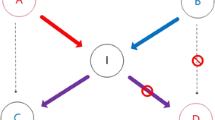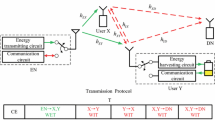Abstract
A group of nearby wireless end devices such as mobile phones can benefit a fast service to satisfy their required packets by cooperating to exchange their packets after receiving collectively from a common base station. This problem can be formulated as a coding and transmission scheme and solved by the linear network coding. We propose a balanced coding and transmission (BCT) scheme that assigns suitable clients to find and transmit linear combinations of the received packets. The goals of our scheme are to minimize the total number of transmissions, to maintain fairness on the number of transmissions among the participants in the cooperative group and to maintain the limited energy resources until all members satisfy their needs. Moreover, we also introduce transmission scheme with physical layer network coding (BCTS/PNC) for the same problem to further reduce the required transmission time slots and accomplish the data exchange process in short time. We present the performance of the schemes and discussion in terms of the fairness, the number of transmissions and the completion time by testing with various simulation parameters and scenarios.







Similar content being viewed by others
References
Chaudhry M, Sprintson A (2008) Efficient algorithms for index coding. In: INFOCOM workshops 2008, IEEE, pp 1–4. https://doi.org/10.1109/INFOCOM.2008.4544612
Courtade T, Wesel R (2014) Coded cooperative data exchange in multihop networks. Inf Theory IEEE Trans 60(2):1136–1158. https://doi.org/10.1109/TIT.2013.2290993
Dong J, Curtmola R, Sethi R, Nita-Rotaru C (2008) Toward secure network coding in wireless networks: threats and challenges. In: 2008 4th workshop on secure network protocols, pp 33–38
Fragouli C, Le Boudec JY, Widmer J (2006) Network coding: an instant primer. SIGCOMM Comput Commun Rev 36(1):63–68. https://doi.org/10.1145/1111322.1111337
Heidarzadeh A, Sprintson A (2015) Cooperative data exchange with unreliable clients, CoRR abs/1508.03871. arXiv:1508.03871
Keshtkarjahromi Y, Seferoglu H, Ansari R, Khokhar AA (2015) Network coding for cooperative mobile devices with multiple interfaces. CoRR abs/1503.02266, arXiv:1503.02266
Liew SC, Zhang S, Lu L (2011) Physical-layer network coding: Tutorial, survey, and beyond. CoRR abs/1105.4261, arXiv:1105.4261
Lin N, Kurkoski BM, Lim Y, Tan Y (2016) Balanced cooperative linear data exchange with physical layer network coding. In: Proceedings of the international conference on internet of things and cloud computing, ACM, New York, NY, USA, ICC ’16, pp 28:1–28:6. https://doi.org/10.1145/2896387.2896413
Mohammad S (2013) Opportunistic cooperative communication using buffer-aided relays. In: Proceedings Qatar foundation annual research forum p ICTP 025. https://doi.org/10.5339/qfarf.2013.ICTP-025
Paramanathan A, Pedersen MV, Lucani DE, Fitzek FH, Katz M (2013) Lean and mean: network coding for commercial devices. IEEE Wirel Commun 20(5):54–61
Rouayheb SYE, Sprintson A, Sadeghi P (2010) On coding for cooperative data exchange, CoRR abs/1002.1465. arXiv:1002.1465
ScienceDaily (2015) Cooperative driving will become common: data exchange between vehicles and road network. Science news from research organizations, Technical Research Centre of Finland (VTT), www.sciencedaily.com/releases/2015/07/150702073740.htm. Accessed 23 Mar 2018
Sui Y, Wang X, Wang J, Wang L, Hou S (2016) Deadline-aware cooperative data exchange with network coding. Comput Netw 97:88–97. https://doi.org/10.1016/j.comnet.2016.01.003
Tajbakhsh S, Sadeghi P (2012) Coded cooperative data exchange for multiple unicasts. In: Information theory workshop (ITW), 2012 IEEE, pp 587–591. https://doi.org/10.1109/ITW.2012.6404743
Zhang Q, Fitzek F, Katz M (2007) Cooperative power saving strategies for ip-services supported over dvb-h networks. In: Wireless communications and networking conference, 2007. WCNC 2007. IEEE, pp 4107–4111. https://doi.org/10.1109/WCNC.2007.750
Zhang Q, Heide J, Pedersen MV, Rikkinen K (2012) Network coding: fundamentals and applications, Academic Press, chap 5 network coding and user cooperation for streaming and download services in LTE networks, pp 115–140. https://doi.org/10.1016/B978-0-12-380918-6.00005-6
Author information
Authors and Affiliations
Corresponding author
Appendix: upper and lower bounds on the number of transmissions
Appendix: upper and lower bounds on the number of transmissions
In this Section, the upper and lower bounds from Rouayheb et al. (2010) are described.
The minimum number of transmissions is greater or equal to \(n-n_{min}\) where n is the number of packets and \(n_{min}\) is the minimum number of packets held by a client, i.e., \(n_{min} = \min _{1\le i\le k}n_i\). If all clients initially have the same number of packets \(n_{min} < n\), i.e., \(n_i = n_{min}\) for \(i = 1, \ldots , k\) clients, then the minimum number of transmissions is greater than or equal to
The upper bound on the minimum required number of transmissions is less than or equal to
for \(|\mathbb {F} |\ge k\). Each client \(c_i\) initially holds a subset \(X_i\) of packets in \(X = \lbrace x_1,\cdots , x_n\rbrace\), i.e., \(X_i \subseteq X\). And \(n_i = |X_i |\) denotes the number of packets initially available to client \(c_i\), and \(\overline{X_i} = X \setminus X_i\).
Rights and permissions
About this article
Cite this article
Lin, N., Kurkoski, B.M., TAN, Y. et al. Data sharing among wireless client devices in cooperative manner with minimum transmissions. J Ambient Intell Human Comput 10, 3329–3338 (2019). https://doi.org/10.1007/s12652-018-0764-9
Received:
Accepted:
Published:
Issue Date:
DOI: https://doi.org/10.1007/s12652-018-0764-9




